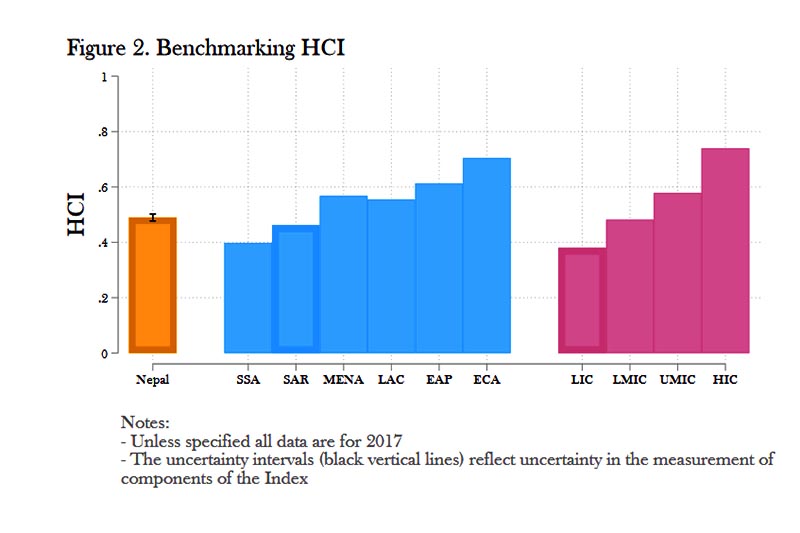Nepal’s human capital index laudable
Kathmandu, October 12
Nepal has secured second spot among its South Asian peers in the human capital index of the World Bank, lagging behind Sri Lanka.
The country scored 0.49 out of the maximum possible score of one. This means that a child born in Nepal today will be 49 per cent as productive when he or she grows up, as he or she could be if he or she enjoyed complete education and full health.
While 97 out of 100 children born in Nepal survive to age five, the report also reveals that 36 out of 100 children in the country are stunted. These children are at risk of cognitive and physical limitations that can last a lifetime, the report states.
Also, children in Nepal can expect to complete 11.7 years of pre-primary, primary and secondary school by age 18. However, when years of schooling are adjusted for quality of learning, this is only equivalent to 6.9 years. This translates to a learning gap of 4.8 years.
“Though lack of data has prevented comparison of HCI by gender in case of Nepal, the country’s HCI in 2017 was higher than the average for the region,” the report states.
In its first report on HCI, which was released in Indonesia yesterday, World Bank has ranked 157 economies on parameters like child mortality, health and education. Globally, Nepal managed to secure 102nd position.
Earlier studies have revealed that without a healthy, educated and resilient population, countries cannot compete effectively in the global economy. Presenting some compelling evidence, the World Bank research has tried to create the pressure on the governments to act.
For instance, the report shows that globally, 56 per cent of all children born today will grow up to be, at best, half as productive as they could be. In other words, ‘56 per cent of the children will lose more than half their potential lifetime earnings because governments are not making effective investment in their people to ensure a healthy, educated and resilient population that is ready for the workplace of the future’.
Investing in the early years is one of the smartest investments a country can make to break the cycle of poverty, address inequality and boost productivity later in life, according to the World Bank.
“Human capital is a key driver of sustainable, inclusive economic growth, but investing in health and education has not got the attention it deserves. This index creates a direct line between improving outcomes in health and education, productivity and economic growth. I hope that it drives countries to take urgent action and invest more — and more effectively — in their people,” World Bank Group President Jim Yong Kim stated.
The HCI is a part of the World Bank Group’s Human Capital Project, which recognises human capital as driver of inclusive growth. Reportedly, some 28 countries (not including Nepal) spanning several regions and income levels have expressed advance interest in participating in the project.
South Asia scorecard
Country Name
Probability of Survival to Age 5
Expected Years of School
Harmonised Test Scores
Learning -Adjusted Years of School
Fraction of Kids Under 5 Not Stunted
Adult Survival Rate
HUMAN CAPITAL INDEX
Afghanistan
0.93
8.6
355
4.9
0.59
0.78
0.39
Bangladesh
0.97
11
368
6.5
0.64
0.87
0.48
India
0.96
10.2
355
5.8
0.62
0.83
0.44
Nepal
0.97
11.7
369
6.9
0.64
0.85
0.49
Pakistan
0.93
8.8
339
4.8
0.55
0.84
0.39
Sri Lanka
0.99
13
400
8.3
0.83
0.87
0.58
Source: World Bank






